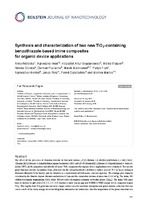| dc.contributor.author | Różycka, Anna | |
| dc.contributor.author | Iwan, Agnieszka | |
| dc.contributor.author | Bogdanowicz, Krzysztof Artur | |
| dc.contributor.author | Malinowski, Marek | |
| dc.date.accessioned | 2018-03-05T10:43:09Z | |
| dc.date.available | 2018-03-05T10:43:09Z | |
| dc.date.issued | 2018 | |
| dc.identifier.citation | Różycka, A. et al. (2018). Synthesis and characterization of two new TiO2-containing benzothiazole-based imine composites for organic device applications. Beilstein Journal of Nanotechnology, 9: 721–739. | en_US |
| dc.identifier.issn | 2190-4286 | |
| dc.identifier.uri | http://dx.doi.org/10.3762/bjnano.9.67 | |
| dc.identifier.uri | http://hdl.handle.net/10566/3563 | |
| dc.description.abstract | The effect of the presence of titanium dioxide in two new imines, (E,E)-(butane-1,4-diyl)bis(oxybutane-4,1-diyl) bis(4-
{[(benzo[d][1,3]thiazol-2-yl)methylidene]amino}benzoate) (SP1) and (E)-N-[(benzo[d][1,3]thiazol-2-yl)methylidene]-4-dodecylaniline
(SP2), on the properties and stability of imine:TiO2
composites for organic device applications were examined. The investigated
titanium dioxide (in anatase form, obtained via the sol–gel method) exhibited a surface area of 59.5 m2
/g according to
Brunauer–Emmett–Teller theory, and its structure is a combination of both meso- and microporous. The average pore diameter
calculated by the Barrett–Joyner–Halenda method was 6.2 nm and the cumulative volume of pores was 0.117 m3
/g. The imine SP1
exhibited columnar organization (Col), while SP2 revealed a hexagonal columnar crystalline phase (Colhk). The imine:TiO2 mixtures
in various weight ratio (3:0, 3:1, 3:2, 3:3) showed a lower energy gap and HOMO–LUMO energy levels compared to pure
TiO2
. This implies that TiO2
provides not only a larger surface area for sensitizer adsorption and good electron collection, but also
causes a shift of the imine energy levels resulting from intermolecular interaction. Also the temperature of the phase transition was slightly affected with the increase of TiO2 concentration in imine-based composites. The changes observed in the Fourier transform
middle-infrared absorption (FT-MIR) spectra confirmed the significant influence of TiO2 on structural properties of both investigated
imines. Similar interactions of oxygen vacancies existing on the TiO2 surface with SP1 and SP2 were observed. The imine:TiO2
mixtures showed good air stability and reusability, which demonstrates its potential for organic device applications. | en_US |
| dc.language.iso | en | en_US |
| dc.publisher | Beilstein-Institut | en_US |
| dc.rights | This is an Open Access article under the terms of the
Creative Commons Attribution License
(http://creativecommons.org/licenses/by/4.0), which
permits unrestricted use, distribution, and reproduction in
any medium, provided the original work is properly cited. | |
| dc.subject | Azomethines | en_US |
| dc.subject | Composites | en_US |
| dc.subject | HOMO-LUMO | en_US |
| dc.subject | Imines | en_US |
| dc.subject | Organic devices | en_US |
| dc.subject | TiO2 | en_US |
| dc.title | Synthesis and characterization of two new TiO2-containing benzothiazole-based imine composites for organic device applications | en_US |
| dc.type | Article | en_US |
| dc.privacy.showsubmitter | FALSE | |
| dc.status.ispeerreviewed | TRUE | |

